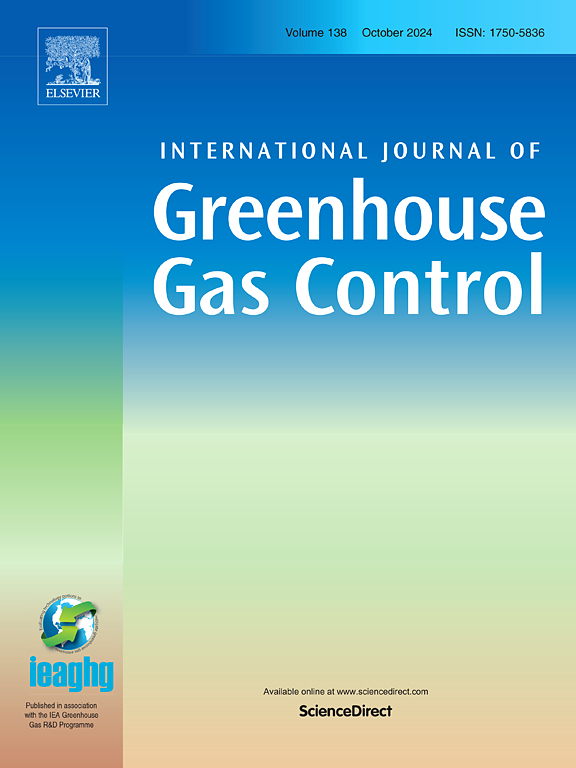中国固体吸附剂直接空气碳捕集与封存的全生命周期平准化成本与除碳效率
IF 5.2
3区 工程技术
Q2 ENERGY & FUELS
International Journal of Greenhouse Gas Control
Pub Date : 2025-08-05
DOI:10.1016/j.ijggc.2025.104440
引用次数: 0
摘要
直接空气碳捕获和储存(DACCS)被认为是最有前途的大规模负排放技术(NETs)之一,为降低大气CO 2浓度提供了巨大的潜力。在这项研究中,我们开发了一个全面的全链固体吸附剂DACCS系统评估模型,该模型集成了所有关键阶段,包括DAC工厂建设,CO₂捕获,压缩,运输和储存。将该模型应用于中国28个省份,评估了36种不同能源供应配置下DACCS系统的生命周期平准化CO₂去除成本(LCOD)和碳去除效率(CRE)。结果表明:(1)余热热水与煤电组合的LCOD最低(260美元/t CO₂),但CRE有限,仅为30%。相比之下,将废蒸汽与核电相结合,以同样低的LCOD(264美元/吨CO₂)实现最高的CRE(97%)。(2)光伏驱动的DACCS在年运行时间为1211小时时达到最高的LCOD(1358 ~ 1502美元/吨CO₂),而水力驱动系统受益于更长的年运行时间(3349小时),实现了高平均CRE(78%)和显着降低的LCOD(529 ~ 622美元/吨CO₂)。(3)沿海省份,如广西和广东,废热水和核电的可用性,提供低LCOD ($243 ~ 249/t CO₂)和高CRE (> 97%)之间的最佳平衡。此外,云南(水电)、内蒙古(风电)和重庆(光伏)等地区在可再生能源驱动的DACCS部署方面显示出强大的潜力。本文章由计算机程序翻译,如有差异,请以英文原文为准。
Life-cycle levelized cost and carbon removal efficiency of solid sorbent direct air carbon capture and storage in China
Direct air carbon capture and storage (DACCS) is recognized as one of the most promising large-scale negative emission technologies (NETs), offering substantial potential for mitigating atmospheric CO₂ concentrations. In this study, we developed a comprehensive full-chain solid sorbent DACCS system assessment model that integrates all key stages, including DAC plant construction, CO₂ capture, compression, transport, and storage. This model was applied to 28 provinces across China to evaluate the life-cycle levelized cost of CO₂ removal (LCOD) and carbon removal efficiency (CRE) of DACCS systems powered by 36 different energy supply configurations. The results indicate that: (1) The combination of waste hot water and coal power yields the lowest LCOD ($260/t CO₂), but with a limited CRE of 30 %. In contrast, pairing waste steam with nuclear power achieves the highest CRE (97 %) at a similarly low LCOD ($264/t CO₂). (2) Photovoltaic-driven DACCS reaches the highest LCOD ($1358∼1502/t CO₂) at 1211 annual operating hours, while hydropower-driven systems, benefiting from much longer annual operation (3349 h), achieve both a high average CRE (78 %) and a significantly lower LCOD ($529∼622/t CO₂). (3) Coastal provinces such as Guangxi and Guangdong, where waste hot water and nuclear power are accessible, offer the optimal balance between low LCOD ($243∼249/t CO₂) and high CRE (>97 %). Additionally, regions such as Yunnan (hydropower), Inner Mongolia (wind power), and Chongqing (photovoltaic power) demonstrate strong potential for renewable energy-driven DACCS deployment.
求助全文
通过发布文献求助,成功后即可免费获取论文全文。
去求助
来源期刊
CiteScore
9.20
自引率
10.30%
发文量
199
审稿时长
4.8 months
期刊介绍:
The International Journal of Greenhouse Gas Control is a peer reviewed journal focusing on scientific and engineering developments in greenhouse gas control through capture and storage at large stationary emitters in the power sector and in other major resource, manufacturing and production industries. The Journal covers all greenhouse gas emissions within the power and industrial sectors, and comprises both technical and non-technical related literature in one volume. Original research, review and comments papers are included.

 求助内容:
求助内容: 应助结果提醒方式:
应助结果提醒方式:


